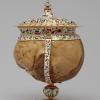Clone of Bezoar
Commentary
Image. Two bezoars belonging from the Science Museum London are depicted; the left one has been identified as coming from the stomach of a camel, which would most likely place its origin in North Africa.
Commentary
Bezoars are stone-like masses that appear in the stomachs of certain animals, particularly ruminants like goats. They are made up of undigestible materials that harden in time and animals can use to ruminate their food. Bezoars, however, have been found in humans as well.
These 'stones' were prized for their medicinal properties in ancient and medieval Middle East and India. The name bezoar itself comes from Persian pād-zahr (پادزهر), which means 'poison expellers'. Their reputation grew in the 11th and 12th centuries, as they were promoted by Islamic physicians mainly as cures against poison. They were slow to pick up in the Latin West, but became increasingly prized in 15th century Italy.
The popularity of bezoars exploded, however, in the 16th century, following the voyages of discovery. Portuguese traders brought them as luxury items from Goa in India. The Dutch and Spanish followed suit, marketing their own imports from overseas. From 1568, bezoars were also found in the stomach of New World ruminants in the Peruvian Andes and marketed by Spanish traders.
The interest in bezoars would have perhaps never taken off without the warm support of famous physicians, who used the medium of print to express their opinions on various medicines and diseases. The tone was set, somewhat surprisingly, in Italy, by Pietro Andrea Mattioli (1501-1577). Soon, however, physicians from Portugal and Spain dominated the discussion, including the Portuguese physicians Amato Lusitano (a Jewish physician), Garcia da Orta and Cristobal Acosta and the Spanish physician Nicolas Monardes. In the 17th century, however, it was Northern physicians that wrote on the bezoar, including the Danish Caspar Bauhin and the German Werner Rolfinck.
Bezoars were considered as effective antidotes against poison. Recent scholarship has pointed out that there may indeed have been a medicinal value to them: as they contain calcium and phosphates, they can at least partially counteract the effects of arsenic. However, in the period they were also praised as valuable against many diseases, becoming a kind of panacea. They were sometimes used in extremis (as a last resort): for instance, it is recorded that dying Grand Duke of Florence Francesco I (1541-1587) unsuccessfully tried to cure himself with bezoar, while prince Gabriel Bethlen of Transylvania (1580-1629) was treated with it in his last days of his life, apparently easing his suffering.
Bezoars were used in a variety of ways. They could be ground into a fine powder and taken or infused with a drink (usually water or wine). They could also be worn around the neck as amulets or set in rings. Others would transform them into cups: this bezoar goblet, for instance, was part of the Rudolfine imperial Kunstkammer. Amulets or goblets could have both an esthetic and practical use, supposedly neutralising poison.
Although chiefly meant as antidotes against poisons, bezoars were also prized as collection items, bridging the gap between medicine and collecting. As they were not particularly attractive at first sight, artisans took to adorning them with gold, enamel and gems. Some bezoars were decorated in India, but many of them were also finished off in Europe. Some fine examples of these items are conserved in Vienna, being related to the Habsburg monarchy and particularly to Emperor Rudolf II.
As they were linked with overseas trade, bezoars remained expensive items throughout the 16th and 17th centuries. Cheaper, alchemically-made substitutes were offered in the 17th century under the name of artificial bezoars or bezoardics. Similarly, the Portuguese Jesuits tried to market a substitute made of several compounds; these are known as Goa Stones. Bezoars seem to have become less popular after the mid-1700s, perhaps due to the rife fraud on the market and the lack of endorsement by 18th century physicians.
Further Reading. Peter Borschberg, "The Euro-Asian Trade in Bezoar Stones (Approx 1500-1700), in Michael North, ed, Artistic and Cultural Exchanges between Europe and Asia, 1400-1900 (Aldershot, 2010), 29-43 / MDS Barroso, "Bezoar Stones, Magic, Science, and Art," in Duffin, Moody, Gardner–Thorpe, eds, A History of Geology and Medicine (London, 2013), 193–207 / Luis Millones Figueroa, "The Bezoar Stone: A Natural Wonder in the New World", Hispanofila 171 (2014): 139-56 / Ana-Maria Gruia, "Bezoar Use in Early Modern Transylvania", Acta historiae medicinae, stomatologiae, pharmaciae, medicinae veterinariae, 35 (2016), 18-28 / Alisha Rankin, Poison Trials: Wonder Drugs, Experiment, and the Battle for Authority in Renaissance Science (Chicago, 2021), ch. 5.
Credits: Georgiana Hedesan (April 2022).

